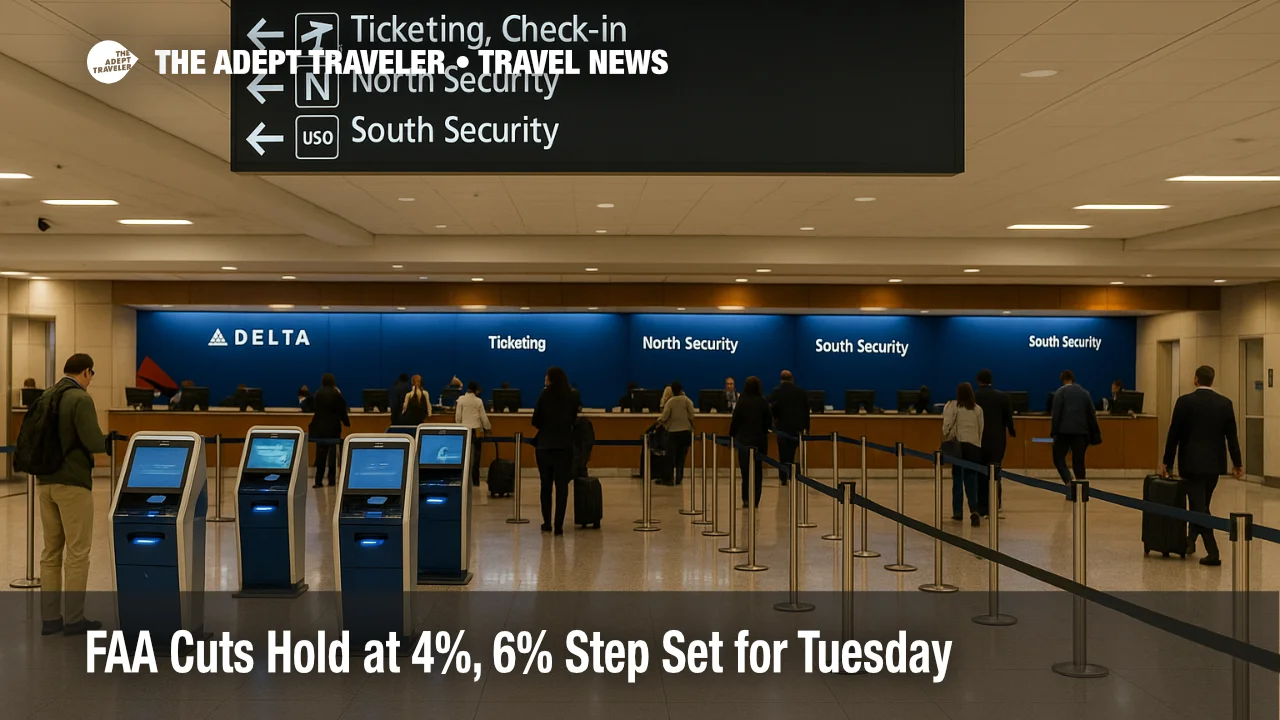FAA Cuts Hold at 4%, 6% Step Set for Tuesday

Key points
- FAA's 4 percent reductions at 40 airports continued Sunday with elevated cancellations
- Plan steps to 6 percent on Tuesday, November 11, 8 percent on November 13, and 10 percent on November 14
- FlightAware showed more than 1,100 U.S. cancellations Sunday with Saturday topping 1,500
- Outliers included Atlanta, San Francisco, Newark, Houston, Dallas, and Washington National on various ground programs
- International flights are largely exempt while airlines issue waivers and upgauge some routes
Impact
- Rebook Earlier
- Move to the first departure of the day and protect tight connections on hub-to-hub flows
- Watch Your Airport
- Atlanta, San Francisco, Newark, Washington National, Dallas Fort Worth, and Houston showed heavier programs Sunday
- Use Waivers
- Check your airline's change-fee waiver and same-day options before departure
- Know The Dates
- Reductions hold at 4 percent through Monday, then 6 percent Tuesday November 11, 8 percent Thursday November 13, and 10 percent Friday November 14
- Expect Queues
- Ground delay programs and staffing triggers can ripple into longer TSA and rebooking lines
Sunday brought another day of elevated cancellations as the Federal Aviation Administration's shutdown traffic plan held at 4 percent trims across 40 high-traffic airports. The phased order moves to 6 percent on Tuesday, November 11, then 8 percent on Thursday, November 13, and 10 percent on Friday, November 14. Airlines are leaning on first-bank rebooks, upgauging, and limited waivers, while international flights remain mostly exempt. Travelers should shift to earlier departures, protect connections, and monitor airport-specific programs before leaving for the airport. Live counts and outliers are below.
FAA step-up schedule, reconfirmed
Federal guidance and carrier notices confirm a phased reduction that began at 6:00 a.m. ET on Friday with 4 percent domestic cuts at the 40 named airports. Agencies and outlets reconfirm the step-ups to 6 percent on Tuesday, November 11, 8 percent on Thursday, November 13, and 10 percent on Friday, November 14 if the shutdown persists. International flights are generally excluded from the mandate. The Department of Transportation has also warned that deeper reductions, up to 15 to 20 percent, could be forced if staffing deteriorates.
Fresh national cancellation counts by bank
Weekend cancellations remained high as carriers executed the mandated trims and absorbed added ground programs. Saturday ended with roughly 1,550 cancellations nationwide and more than 6,700 delays. By Sunday midday, major outlets citing FlightAware reported more than 1,100 cancellations, with tallies continuing to climb into the afternoon. As of our latest sweep of FlightAware's live dashboard, U.S. cancellations were above 1,100 and rising. Treat these figures as live snapshots that can change quickly with additional programs or staffing triggers.
Morning bank, Sunday, November 9. Cancellations had already crossed into the four figures by late morning as first-bank operations met reduced acceptance rates at several facilities. FlightAware's U.S. cancellation line pushed past 1,100, with delays concentrated at select hubs running ground delay programs.
Midday bank, Sunday, November 9. By early afternoon, national cancellations remained above 1,100 with delays compounding at airports under formal programs, driven primarily by staffing triggers and metering. Press tallies and the FAA's advisory feed aligned with continued GDPs at multiple hubs.
Evening bank, Saturday reference. For context, Saturday's second day under the order closed at about 1,550 cancellations nationwide, setting expectations for similar pressure into Sunday evening if additional programs are issued.
Outlier airports to watch
FAA advisories and wire-service snapshots highlighted recurring pressure at Hartsfield-Jackson Atlanta International Airport (ATL), San Francisco International Airport (SFO), Newark Liberty International Airport (EWR), Ronald Reagan Washington National Airport (DCA), Dallas Fort Worth International Airport (DFW), and George Bush Intercontinental Airport (IAH). On Sunday, the FAA's operations plan and NAS Status tools showed ground delay programs, timeouts, or staffing triggers affecting parts of New York, Texas, and the Mid-Atlantic, with program notes citing EWR and LaGuardia flows, and GDPs posted at DFW, IAH, and Houston Hobby. Expect these to rotate by hour as demand, staffing, and en-route constraints shift.
How the order works
The FAA's directive instructs carriers to remove a fixed share of domestic departures during the 600 a.m. to 1000 p.m. local operating window at 40 specified airports. Airlines must distribute cuts evenly to avoid disproportionate community impacts, file rolling plans, and honor consumer refund rules for cancelled flights. The agency paired the trims with ground delay programs and other traffic management initiatives at affected facilities as needed to preserve safety margins given controller staffing levels. Carriers have responded with limited waivers, resequencing aircraft, and upgauging where slots are constrained.
Traveler playbook
Book the earliest feasible departure, because first-bank flights are more likely to push on time and give connection buffers. If your route touches the listed outliers, move to a longer connection or a same-airport connection that avoids tight cross-terminal transfers. Check your airline's waiver page, then change before you leave for the airport to keep choice inventory. If you must connect, pick hubs that did not feature in today's GDP stack. Reconfirm your itinerary the evening before travel and again two hours before you depart.
Final thoughts
Barring a funding resolution, the plan advances to 6 percent on Tuesday, November 11, then 8 percent on November 13, and 10 percent on November 14, keeping pressure on the morning and midday banks at the 40 named airports. Track your airport on the FAA NAS Status page, watch your carrier's waiver page, and favor earlier departures to protect your trip.
Sources
- FAA Daily Air Traffic Report, ATCSCC Advisories
- National Airspace System Status
- FAA Releases Details On Flight Cuts That Start At 6 A.M. Friday
- Which Airports Are Affected By Forced US Flight Reductions
- US Finalizes Domestic Flight Cuts To Start At 4% On Friday
- US Airlines Brace For Third Day Of Government-Mandated Flight Cuts
- U.S. Flight Cancellations Upend Weekend Travel As Shutdown Drags On
- Live Airline Flight Cancellations Info & Statistics
